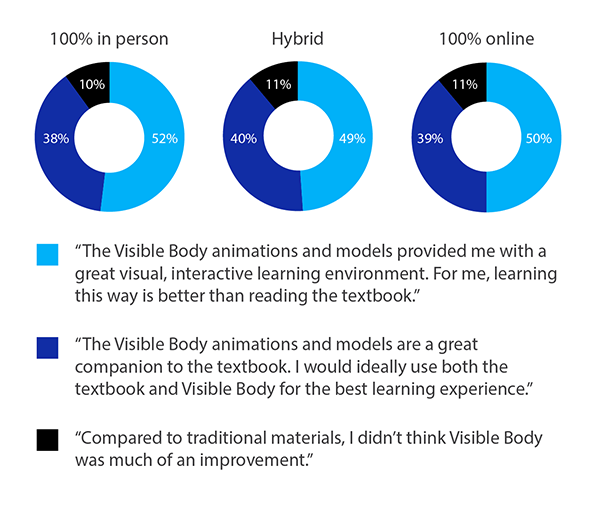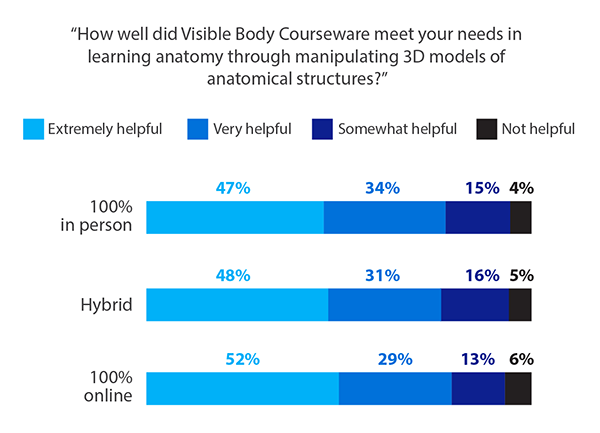Posted on 3/4/22 by Andra Bowditch
With all the speculation about how education will or won’t be permanently altered by the pandemic, here at Visible Body, we’ve found that we’ve been inadvertently running something of a real-time experiment that gives us clues to what the future holds.
During the Fall 2021 semester, hundreds of instructors used Visible Body Courseware to teach anatomy and physiology to tens of thousands of students. Reflecting the variety of approaches of teaching and learning during the second year of the pandemic, Courseware was used in classrooms that were remote, in-person, or hybrid.
At the end of the semester, we surveyed these students. User feedback is vital to our company; we are always looking to track how we are doing and to continuously improve our products. As always, students were generous in sharing their thoughts about Courseware, with over 1,250 of them responding to our questionnaire.
Because we had a large number of respondents whose course was 100% online (500+), 100% in person (~450), and hybrid (~300), we were able to compare how each cohort used and how each felt about a digital content solution, in this case Visible Body Courseware. This data gave us a unique opportunity to look at what students’ experiences might predict for the future.
We were curious: does the mode in which students are learning (online vs. in person) affect the perceived usefulness of digital content? One hypothesis might be that when compared to online students, students attending in-person lectures are less inclined to value digital materials. If that were the case, it would suggest that as the pandemic recedes and more students return to in-person learning, the use of digital learning materials will gradually ebb.
In looking at our data, however, we found that this hypothesis does not hold up for Visible Body Courseware. In-person, hybrid, and online students were very much aligned in their overall evaluation of Visible Body compared to traditional course materials such as textbooks. About 50% of all three groups said Visible Body was better than a textbook and nearly 40% said that Visible Body is a great companion to the textbook:

Furthermore, over 90% of all three groups found Visible Body’s 3D models to be helpful in learning anatomy, with the great majority saying they were extremely or very helpful. There was no substantive difference in the evaluation of Courseware as being a useful learning tool, regardless of whether students were in person or online.

Given that students uniformly value Visible Body’s digital content, no matter what their learning mode, we have more clarity about the future when we look into our own crystal ball. First, this generation of students was already accustomed to digital learning prior to the pandemic, and the end of the pandemic certainly won’t cause them to abandon their screens. And second, instructors will ultimately benefit from what they have learned during the pandemic about multimodal instruction. They will continue to leverage digital content alongside their in-person teaching to provide the best, most engaging experience for their students long after the pandemic is a distant memory.
Be sure to subscribe to the Visible Body Blog for more anatomy awesomeness!
Are you an instructor? We have award-winning 3D products and resources for your anatomy and physiology course! Learn more here.
When you select "Subscribe" you will start receiving our email newsletter. Use the links at the bottom of any email to manage the type of emails you receive or to unsubscribe. See our privacy policy for additional details.
©2025 Visible Body, a division of Cengage Learning